Heathcote: A Viticultural Paradox
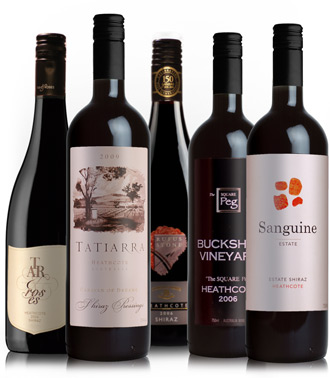
Heathcote is something of a viticultural paradox:
a district where young vines that would be considered 'immature' elsewhere, consistently produce stunning symphonies of flavour.
Perhaps no other wine region in the world has established itself so dramatically in such a short time. Even though the regions viticultural history actually dates back to the mid 19th Century, the most influential developments can be chronicled throughout Heathcote's recent thirty years of erratic activity. Today the district continues its quiet expansion, the big companies such as BRL Hardy, Southcorp, Beringer Blass, Brown Brothers and Tyrrell's all have a major presence amongst a number of small to medium sized vineyards including Whistling Eagle, Barnadown Run, Tatiarra, Mount Burrumboot, Buckshot, Sanguine Estate and Toolleen Vineyard to name a few. Two small vineyards have captured the world's imagination in particular - Wild Duck Creek and Jasper Hill.
A History of Wine Making in Heathcote
While Jasper Hill was undoubtedly the catalyst for Heathcote's modern wave of viticultural activity, wine making in the district began with the pioneering efforts of German immigrants. Henning Rathjen, recognised as one of the great 'Middle Period' Australian pioneers, was born on the first of April 1826 in Germany and moved to Australia around 1850. In 1858, the land around the township of Colbinabbin, north of Heathcote, was opened for selection and Henning along with two mates made the trip to Colbinabbin. After deciding to settle in the region, farming commenced and a vineyard was eventually planted by Henning in the 1860's consisting of Shiraz and Marsanne vines. Further plantings were envisioned after his wines were awarded accolades at the local Rochester Wine Show. The original vines Henning planted no longer exist, however the structure of the original wine cellar remains.
The recent revival of grape growing in the Heathcote district was driven by two Italians who have left an incredible legacy, demonstrating their wonderful sense of the future. Albino Zuber planted his vines on the site that has recently been acquired by Shadowfax Winery. Albino's block is on the highway on the left hand side as one leaves Heathcote. The Shiraz vines are now quite mature, having developed thick, stumpy trunks. Albino was a man of the land, uncomplicated with a gentle manner. He was quite tall for an Italian, and built in a very solid manner that easily made him an integral part of the vineyard landscape. Always softly spoken, he made his own wine in the early years, often in a very traditional peasant style, but later relied on the wine making skills of John Ellis. The site, subject to frost, proved to be a difficult one however Albino persevered naming his brand Zuber Estate . His 1992 Pink Cliffs Shiraz was one of the highlights of his career and clearly demonstrated the capacity of the site to produce extraordinary wine from a good year. Bruno Pangrazio is the Italian inspiration behind Jasper Hill, and it was he who planted the vines on the property that
VIDEO CLIP: Interview with Ron Laughton,
Modern Pioneer of the Heathcote Wine District. 7.2 MB. Requires Flash Player 8 or higher. Click here to download the player. |
Ron and Elva Laughton purchased in 1975. The first vintage that they produced under the distinctive Jasper Hill label was in 1982, and caught the market by surprise. Ron, a food scientist, and his wife Elva, a milliner, used their working talents to produce a superb 'lazy wine makers' wine which was coupled with an extraordinary slick presentation. Elva stuck vintage ribbons around the necks of each bottle with milliner's adhesive to create a unique style that projected their ambition to produce exceptional wine. There can be no doubt that the district owes its reputation almost solely to the efforts of the couple who consistently have produced exceptional wines from their dry lands vineyard.
Artist Len French, known internationally for his spectacular ceiling in the National Gallery of Victoria, became fascinated with Shiraz during a trip to France in the early 1970's. Len tells the story that he visited many vineyards in Burgundy and the Rhone and crushed samples of dirt in his hands to see if there were any visual comparisons with the Cambrian soils of Heathcote. He came to the conclusion that the Shiraz grapes from the Rhone Valley would be most likely to succeed, and so in 1975 together with a friend Dr James Munro, planted the Mount Ida vineyard (adjacent to Jasper Hill). At the time of planting, Shiraz vines were being pulled up in South Australia, giving rise to the phrase French's Folly. He was an artist and such an indulgence could be understood in that context. The Mount Ida vineyard produced exceptional wines, and when Len and his doctor mate got tired of growing grapes the vineyard was sold on. The Mount Ida vineyard has changed hands several times, and is now a part of the Beringer Blass Empire. The Tudhope family established Heathcote Winery in the main street in the early 1980's as well as planting new vineyards on Cambrian soils south of the township. The family were one of the district's early pioneers, popularising their rich full bodied Shiraz and Chardonnays which were made in the winery located behind the existing cellar door. In 1980, the exuberant Dave and Dianna Anderson of Wild Duck Creek Estate made their appearance in the district and gained a huge cult following with their Duck Muck - a Shiraz Pressings which has sold in excess of $3500 in magnum, scoring near perfect ratings from American wine authority Robert Parker.
Bit by bit, the wine bug caught the imagination of enthusiasts - ex Melbourne stock broker Leigh Hunt planted Huntleigh in 1975 with Riesling, Gewurztraminer, Merlot, Cabernet Franc, Cabernet Sauvignon and Shiraz, producing some excellent Cotes du Rhone styles over the years. Robyn and Peter Turley planted a small vineyard McIvor Creek in 1973. In 1955, Paul Osicka established his vineyard at Graytown on the eastern edge of the present Heathcote region. His reds were big and matured well. Peter Dredge's Red Edge vineyard was established in 1971. In 1992, Adrian Munari and his partner Deborah Jones purchased Graham Lewis' vineyard then called Lady Creek and renamed it Munari Wines. Andrew Millis established Barnadown Run near Toolleen on the western face of the Mt Camel Range in 1994. The word had got out and more professional people emerged in the district, one notable success being Tony Hunter and his family at Sanguine Estate. Up to this time most of the plantings had been quite small, and then the big boys moved in; Brown Brothers with Patricia Park, Southcorp Wines with 1,000 acres North of Colbinabbin (known locally as South Park) and Tyrrell's Wines in 1994 on the North face of Mt Camel. Today there are 4,000 acres planted in the Heathcote region, with another 6,000 acres scheduled to be planted over the next decade. The Rathjen family has reasserted their presence with Ian and Lynn planting the Whistling Eagle Vineyard in 1994, brother Daryl planting vines on the original site in 1998 and sister Louise establishing a new planting opposite the old family home in 2000. The cycle has turned the full circle and now the serious wine history of the region is being written.
Heathcote's Appellation.
The Geographical Indication Committee (G.I.C.) has recently declared the boundaries of the Heathcote region - these are quite extensive, and have created much debate. The declaration now clearly defines wines that may be labelled as originating from Heathcote. 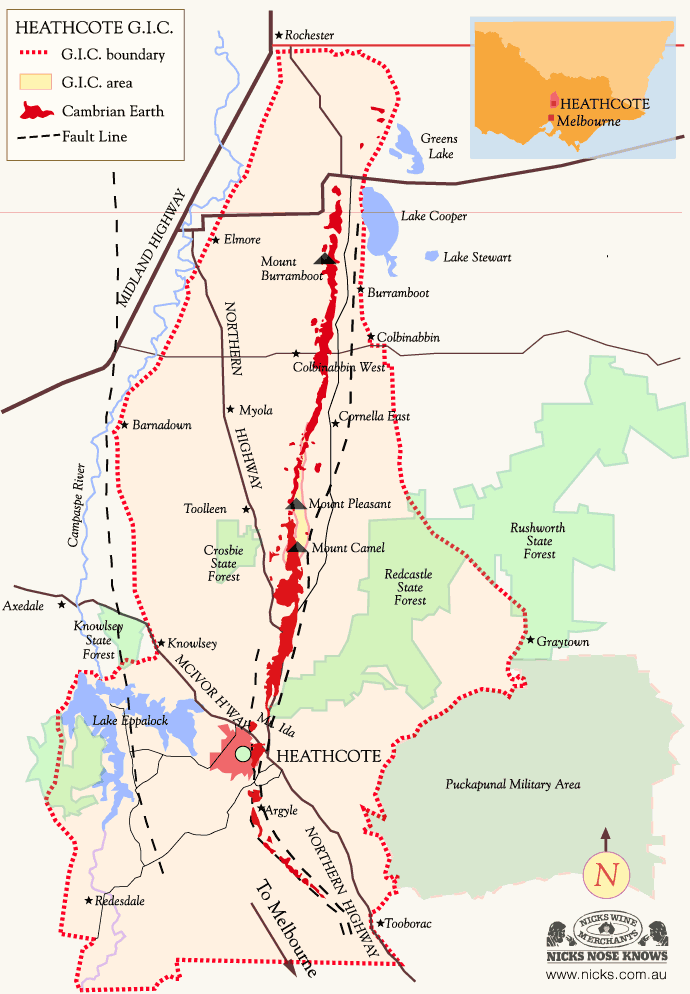
The above diagram represents a 15km cross section taken NE - SW through the Pink Cliffs region of Heathcote (approximately 5 kilometres south of Heathcote township). The red sections marked represent earth identified as Early Cambrian belonging to the "Heathcote Volcanics" group otherwise referred to as "Mount William Volcanics". Chief composition: basalt; deep marine boninite: phenocrysts of pyroxene, chromite, plagioclase; spherulites: minor rhyolite lava, volcanic sandstone, ash, hyaloclastite breccia.
Geological information Source:- 1. Wohlt, K.E. & Edwards, J. Zone 55, Heathcote Geological Map. October 1999. Department of Natural Resources & Environment.
2.- Geology Discovery Guide to Heathcote's Forests, "Tracks & Trees", Heathcote Forest Ecotourism Project.
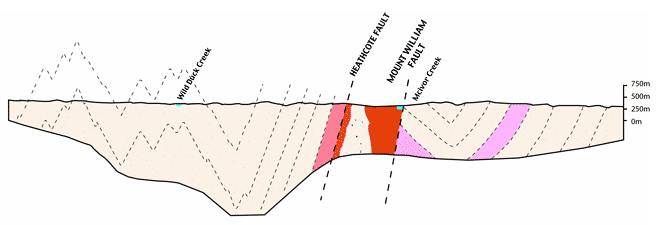
Heathcote, located in Central Victoria, is bound by the township of Rochester to the North, the community of Tooborac to the South, Lake Eppalock to the West and Gray town to the East. Within the region there are many subregions and consequently differing terroirs and micro climates. No one has claimed that the district is homogeneous and it is this variation of terroir that gives the wines of the region their richness and diversity. Historically, while the oldest vineyards have been planted closest to the township of Heathcote, this does not necessarily mean that they necessarily have the most ideal terroir for growing exceptional grapes. The truth is that it is too early to know, and it will possibly take a century or longer to determine which sites produce the best wines. In the meantime, the variation in style of Heathcote wines remains a question of preference and market forces.
The size of the district means that the climate geology and topography will vary greatly. The main variations are apparent as one travels from Tooborac towards Rochester. The North is drier than the South and likely to receive on average 5-10mm less rain per month during the vines' growing season (April to October). Southern vineyards also experience cooler temperatures during the growing season. These can vary between 1.8 and 1.4 degrees Celsius lower, resulting in an extended growing season. This variation in temperature during the grape ripening period results in a spread of picking dates, and subsequently the development of a range of different flavour profiles. Chardonnay, Shiraz and Cabernet Sauvignon for example may ripen from 12 to 14 days later in Southern vineyards than they would in the Northern areas of the region. Much work has to still be done to exploit the differences in ripening times and it could take years before the most optimal matrix of flavour combinations can be found, indeed if they can ever be found.
The Geology of the District.
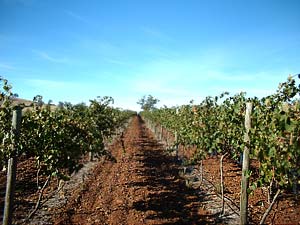
To see the variable geology of the region, the best approach to Heathcote from Melbourne is through Romsey and Lancefield. On leaving Lancefield and crossing the Divide, you drive through rugged scenic country dominated by huge granite rocks. Many of these were dropped out of melting glaciers, and the striated pavements scratched by the passing ice. As you approach the T-junction with the Mclvor Highway at Tooborac, the country flattens out. The Mclvor creek flows on the left hand (east) side of the highway to Heathcote. The country you are now seeing is formed of sediments laid down on the floor of a sea that covered the area in the Devonian period. It is estimated that when the sea receded, about 7,000 metres of mud was left. Three classes of events have occurred to modify the situation since.
1. The first geological process, which began the moment the surf receded over the horizon, was erosion. Most of that seven kilometres of soft sediments began to wash down drainage lines and was blown by the wind into the Murray basin, so forming the flat country to the north and west. As the mud hardened, various forces such as gravity, tectonic plate movements and volcanic pressures acted on it to tilt and fold the flat sheets into a tangled complex form. The results of these forces can be seen in road cuts along the Mclvor and Northern Highway and on the Heathcote-Nagambie road.
2. The next process was the one that subsequently had a key influence on the history and economy of Heathcote from 1852 until today. This was the welling up of molten rock and the eruption of volcanoes through the sediments. This puffing of magma up into the sedimentary rocks baked or metamorphosed these into harder minerals with changed chemistry, appearance and physical characters. The igneous material intruding the sediments also brought solutions of soluble metal compounds and these solidified and interacted with the mixture of igneous and sedimentary rocks in complex ways to leave deposits of insoluble compounds. The most important of these in economic terms was gold, but ores of silver, copper, antimony etc were also laid down, together with numerous minerals with a beautiful appearance such as jasper, chert, selwynite, and corundum.
The main outcrop of igneous Cambrian rock, the Heathcote Greenstone occurs in a strip running from the south end of Heathcote to the junction of the Mclvor and Northern Highway at the north end of the town. The outcrop then follows the west side of Mount Ida to become really impressive as Mount Camel and Mount Pleasant, bare rolling hills to the west of the Northern Highway towards Toolleen; this is said to be the largest lump of Cambrian rock in Victoria, so enjoy it! These Cambrian rocks burst onto the scene through two cracks, the Mclvor fault which runs to the east of the creek and the Heathcote fault which runs from the Argyle forest in the south through Red Hill and Bald Hill to cross the Mclvor creek just north of the Bendigo to Elmore road junction. These faults represent a very long split running throughout Victoria and are even associated with changes in the course of the Murray.The faults are cracks between two plates of sedimentary rock. Did the faults result from tectonic movements of the plates or was it split open by a volcanic hot spot pushing from below? Ask a geologist! To the north the Mclvor fault becomes renamed as the Mt Ida fault and passes to the west of Mt Ida. The Heathcote fault continues north to the west of Mount Camel until we lose interest in it towards Elmore. So the Heathcote area can be considered as two slabs of rolling, folded, eroded sedimentary rocks separated by a strip of super complex minerals formed by volcanoes, igneous intrusion and metamorphosed sediments with all sorts of mineral lying around in the rubble. However there is another complication...
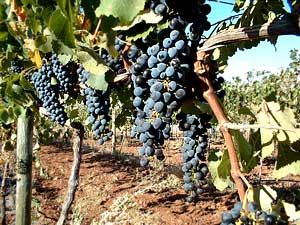
3. Press on along the road to Eppalock Bridge 6 km from town and you run into the residues of those ice sheets that grooved the rocks south of Tooborac. The rolling country here is made up of gravel dropped from the toe of an ice sheet or glacier flowing north and west, off the dividing range. The rocks and gravel fragments found in this tillite mostly came from miles away to the south. This glacial tillite country starts at the north- west end of the One-eye forest at Derrinal and runs south through the Spring Plains area and far off to the north.
During the erosion/weathering process of the Cambrian intrusion lumps of heavy gold were left behind in the creek beds and this alluvial gold was easily discovered and extracted. When this gold was exhausted, methods of mining deep leads of gravel were worked out. Subsequently gold locked up in quartz outcrops was identified and extracted by crushing. Modern methods have enabled stage four of gold extraction to be started, using machinery to remove overburden and pick out mineralised rock patches from more than 100 metres below the surface. The geology exposed by this process is spectacular and the scars left on the country are horrific.
The sedimentary rocks to the east of the creek include Mt Ida and the Range reserve and are Devonian in period; they are a mixture of sandstones, silts, mudstones, shales and conglomerates. Some of these can be identified by characteristic fossils, others are fossil free. As you drive towards Costerfield you cross sequentially the Mt Ida, Dargile, Wapentake and Costerfield series. Another fault occurs at Costerfield also running north-south. This does not seem to be associated with outcrops of igneous rocks, but the sedimentary rocks became metamorphosed and mineralised along the fault lines and have been (and are being) mined for gold, antimony etc.
To the west of the Heathcote fault the country is also sedimentary, and looks similar to the Costerfield country but the sandstones and mudstones are older, dating from the Ordovician period and known as the Lancefieldian series. These sediments are partially covered by the glacial gravels already mentioned, which stretch from north of Eppalock to south of Spring Plains. The Lancefieldian sediments then continue west to the Campaspe River. The complex rocks in the fault system running through Heathcote are known to geologists as the Heathcote Greenstone, though to a botanist they mostly seem pink, red, white and brown! They include granodiorite, volcanic ash, acid dykes dating from the Devonian and altered Cambrian sediments such as Schistose Diabase and Agglomerates.
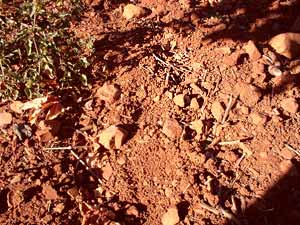 Australian wine writer Max Allen wrote in The Wine Magazine in April/May 1999: " Follow the Northern Highway until you reach Elmore, turn east on the Midland Highway towards Corop, then South again on the Rochester Road, back to Heathcote. Within this long, thin upside down triangle (and occasionally spilling out from the sides of it) can be found some of the most exciting grape-growing dirt in Australia. You see, the red wines (shiraz, mostly) made from grapes grown in this deep Cambrian soil have something that sets them apart. They are unusually deep in colour, and this depth of colour remains stable for an unusually long time. Flavour, too - inky dark, ripe and black - seems to be present in uncommon volume. For the technically minded, it has something to do with the potassium levels in the soil resulting in low pH fruit, something to do with the warm, reliable, dry climate, and something to do with the great depth of the soil resulting in good root penetration. "
Australian wine writer Max Allen wrote in The Wine Magazine in April/May 1999: " Follow the Northern Highway until you reach Elmore, turn east on the Midland Highway towards Corop, then South again on the Rochester Road, back to Heathcote. Within this long, thin upside down triangle (and occasionally spilling out from the sides of it) can be found some of the most exciting grape-growing dirt in Australia. You see, the red wines (shiraz, mostly) made from grapes grown in this deep Cambrian soil have something that sets them apart. They are unusually deep in colour, and this depth of colour remains stable for an unusually long time. Flavour, too - inky dark, ripe and black - seems to be present in uncommon volume. For the technically minded, it has something to do with the potassium levels in the soil resulting in low pH fruit, something to do with the warm, reliable, dry climate, and something to do with the great depth of the soil resulting in good root penetration. "
Over the past 30 odd years the pioneers of the Heathcote district have extolled the virtues of having their vineyard planted on Cambrian earth - the soils are the result of a very long weathering process, having been formed from Cambrian rocks which are over 500 million years old. These ancient soils, geologists inform us, are around 100 million years old. The Cambrian earth exists as two narrow bands that run parallel to the Mount William fault line (see map above). The Cambrian earth starts approx 5km South of the Heathcote township and extends North for approx 35km. The bands of earth are quite narrow, no more than 2km across and are not continuous, although they extend to the Northern end of the region. The Cambrian earth runs either side of the Mt Camel range, following the road from Heathcote to Colbinabbin. Traveling north, it is the land on the left side of the road that is so highly sought after. The slopes are gently, well drained and generally above the frost line. It is this Cambrian earth that, like the terra rossa of the Coonawarra, confers the area's unique ability to produce extraordinary Shiraz. Much of the land is yet to be planted to vine and local farmers who have this soil profile on their properties have realised its real estate potential and are demanding high prices per acre compared to farms on grey loams.
Visiting Heathcote's Vineyards
The town of Heathcote has a population of about 3,500 - a far cry from the 35,000 at the height of the golden days. Still thriving and typically rural, it is nestled in a picturesque bush landscape. The local tourism industry caters well to the wine traveler with a range of accommodation and eateries in the town of Heathcote and surrounds.
Barnadown Run is well worth the short detour from the highway, if not to taste the wines then for the view alone. The smartly designed contemporary winery overlooks a vast panorama of pastures, forest and timeless stands of eucalypts. Named after the original pastoral lease which encompassed the property, Barnadown Run is a 40-hectare property on t he western slopes of the Mt Camel Range, 20 kms north of Heathcote. As well as the rich soil which offers good drainage and excellent moisture retention, the hillside location means the vineyard catches the breeze which helps prevent mildew and is above the frost line. Following several years successful exporting, chiefly to the United States, Barnadown Run's founder / viticulturalist / wine maker, Andrew Millis has secured a more permanent presence in Melbourne for his central Victorian label.
The 28th of March, 2001 was an auspicious occasion for Ron Laughton at Jasper Hill. At around 4:30pm in the afternoon all the grapes for Emily's Paddock were harvested, and as it happens this event coincided with perfect physiological ripeness, and from a biodynamic perspective, the 'right phase of the moon'. Laughton could hardly be considered a new age 'nutter' given his science background, but from his own observations he has noticed some important correlations in plant and flavour development which correspond to moon cycles. While not everyone will agree with his philosophy, Ron Laughton continues to produce exceptional, refined Shiraz (and in parallel manages to increase his prices every year!) The first vintage of Jasper Hill produced was in 1982 and it caught the market by surprise. To this day, Jasper Hill remains a benchmark Heathcote producer and is still considered by many as the label responsible for Heathcote's reputation as a great Shiraz region.
Sanguine Estate was established as a vineyard in 1997 on ancient Cambrian Earth. The Hunter family comprising Linda and Tony and their two children Mark and Jodi with their respective partners Melissa and Brett, worked weekends to establish the initial 16 acres that grew rapidly over the following years to a 55 acre vineyard by 2002. Sanguine Estate now employs Mark as the full time vigneron and Jodi as a part time marketer and business developer for the wines. Sanguine Estate's inaugural vintage released in 2000 scored an amazing 98/100 (Vintage Direct Issue 49 September 2001). The wine was described as a "fruit bomb" and according to one American wine writer, " finished with a 45 second residual sensation " making him an instant fan. The word quickly spread and the entire vintage sold out in less than one week.
The Heathcote Winery is located in the main street of Heathcote, with our cellar door housed in a gold-rush era miner's store. The Winery is open 7 days 11am to 5pm. Wine tasting and gallery entry are free. A selection of glassware, gift packs, gourmet foods and wine accessories are also available.
| The Heathcote Wine and Food Festival This annual event in October showcases the region's wines, introduces you to the winemakers, as well as offering seminars to further your appreciation. In previous years, the Wine & Food Festival has also included games of Petanque, live music, matching cheese with Heathcote Wines and chefs preparing local produce Needless to say, the experience of tasting some of the most exciting wines in Australia might be enough for most. Parking is within the Show grounds, so the walk is short. To find out more, visit: http://www.heathcotewineandfoodfestival.com.au |
